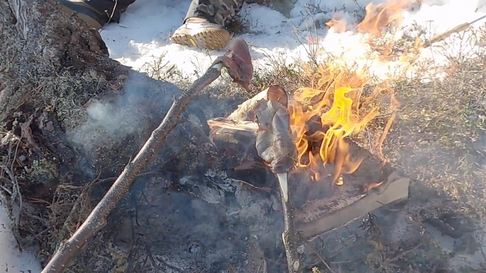Sámi Food Culture : Virtual workshop Day 1
- Dialogues & Encounters

- Jun 17, 2021
- 4 min read
Updated: Aug 27, 2021

A two-day virtual workshop on Sámi Food Culture and Environmental Observations
This online workshop was organised as part of the Dialogues and Encounters in the Arctic project and held on May 19th and 20th 2021. The event gathered around 20 participants from Finland, Norway and Sweden to discuss themes and issues connected to sustainable and traditional Sámi cultures and local environmental observations from an Arctic Indigenous perspective. For two days the workshop managed to connect people and projects across the borders to share thoughts, ideas and observations with traditional knowledge holders, reindeer herders, experts, researchers and students. Important questions and themes were discussed and set the ground for further dialogues and cross-border collaboration.
Day 1: Sámi Food Cultures
The first day Sámi food culture revolved around short documentary films by Marina Falevitch and Arto Saijets from the Sámi Education Institute (Sogsakk), as well as presentations by Janne Näkkäläjärvi on reindeer husbandry in Finland and Ellacarin Blind on the Slow Food Sápmi project.
When Dialogues and Encounters in the Arctic project started in March 2020, the initial goal was to have in person encounters in lávvu settings, but since Covid-19 restrictions came into place the same week the project started, the activities needed to be organised remotely and on digital realms through digital media. This challenging setting led Marina Falevitch to start filming and her husband Arto Saijets doing various activities with a GoPro camera. Marina and Arto are who both main collaborators in the project (from Sogsakk, the Sámi Education Institute in Inari), and have managed to collect almost 100 hours of documented film material of traditional Sámi knowledge in an educational and personal way. Discussions during the first day of the workshop were primarily based on a selection of material related to Sámi Food Cultures, which were edited into four short documentary films about fishing and smoking meat. These were filmed in Anárjohka area. Participants were given exclusive access to these films before the workshop. These were used as a basis for discussions.
Some still frames from the films, which focused on reindeer meat preparation (smoking the meat), lake fishing and making fish and potato soup
As a reindeer herder himself, Janne Näkkäläjärvi he knows about the contemporary state of reindeer herding in Finland and the legislation and politics around it. In the reindeer herding act in Finland, the animal is seen as a domestic animal, analogical to a cow. This conflicts with the Sámi view of reindeer as a nomadic animal. In his view, the Norwegian law is better at supporting the nomadic lifestyle of herders. He reckons whether this is because in Norway, unlike Finland, reindeer husbandry is an exclusive right of the Sámi. In sum, reindeer herding is in his view a central part of the culture and language of the Sámi. Näkkäläjärvi stated that 80 % of all the reindeer meat comes from calves in Finland. There are various reasons for this, many related to regulations since it is not a traditional Sámi way of reindeer husbandry (e.g. limiting the number of reindeer or uncounted calf losses by predators).
Discussions highlighted the need to teach traditional food and cooking in schools, such as blood sausages and other traditional dishes and the commercial potentials and limits of Sámi Food Culture. Marina and Arto’s films present themselves a valuable outcome for the project both in terms of the content they present, but also the discussions that emerge from them.
What are ways of documenting Sámi traditional knowledge in a way that empowers locals to be central actors in the process? How could these films and the footage be used in the near future?
Ellacarin Blind who introduced the Slow Food Sápmi’s Guollegolli fishing project. Slow Food Sápmi is an industry organisation that develops and utilises the Sámi food, food security and food sovereignty covering the whole Sápmi. The Guollegolli project is about filming traditional fishing and documenting knowledge what to fish, where and when. Through digital media and documentaries, the project aims to raise interest especially among youth about traditional fishing. The project is also creating a business and economic model that targets to define and evaluate the price for the fish and meat including all the costs that comes from the process.
New connections were made with another ongoing Skolt Sámi project about traditional fishing as the knowledge is disappearing. The Swedish side of Sámi community and also Skolt community share the same concern about the youth who are losing the knowledge how to fish: they don’t know where to fish and when and how to do it. The administrative restrictions related to fishing are also a barrier for many. In that sense it’s important to film not only for the knowledge, but according to record and store the language especially in the Skolt community.
Discussions highlighted how taste of the food is changing when the climate is changing. Taste is consequence of the food that animals consume. When for example the waters are getting warmer and different algae starts to grow, it will eventually change the taste of the fish. Fresh food has better nutrient values and different parts of an animal are consumed for different nutrient intake: e.g. fish skin has certain important enzymes and traditionally fish skin has fried before eating it. Moreover, household fishing (i.e. fishing to provide for your family) is an activity that women have done in order to take care of the families. This topic and the relation about fishing and gender would be another important discussion and theme that for future research.
Summarised by Mari Viinikainen and Caoimhe Isha Beaulé with help from Teemu Loikkanen and Áilu Valle. University of Lapland
Relevant links:















Comments